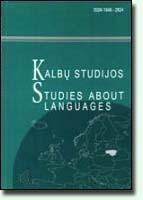Becoming an L2 User: Implications for Identity and Culture in the Language Classroom
Becoming an L2 User: Implications for Identity and Culture in the Language Classroom
Author(s): Jane CrawfordSubject(s): Language and Literature Studies
Published by: Kauno Technologijos Universitetas
Keywords: linguistic and cultural differences; multicultural world; international and local English
Summary/Abstract: Increasingly the goal of both foreign and second language programs is to develop effective language users able to move comfortably between two or more languages and cultures and negotiate the linguistic and cultural differences frequently encountered in an ever more interdependent and multicultural world. While this is true of all language programs, the status of English as a global lingua franca means that this language is now used frequently in contexts where it is not the first or dominant language of any of the interactants. This paper reviews some of the literature exploring this emergence of English as an international lingua franca and discusses the implications for language teachers (and learners) of this change in status of English. The paper focuses in particular on how local uses of English are likely to influence the learners’ sense of identity, while its use with other L2 users raises the need for learners to negotiate difference across a range of cultural boundaries rather than between their first culture(s) and those of the various English-speaking cultural communities. This expansion of the contexts in which English is used also has important implications with regard to the choice of appropriate models or standards thus challenging the traditional dominance in TESOL of native speaker norms.
Journal: Kalbų Studijos
- Issue Year: 2006
- Issue No: 8
- Page Range: 70-76
- Page Count: 7
- Language: English

